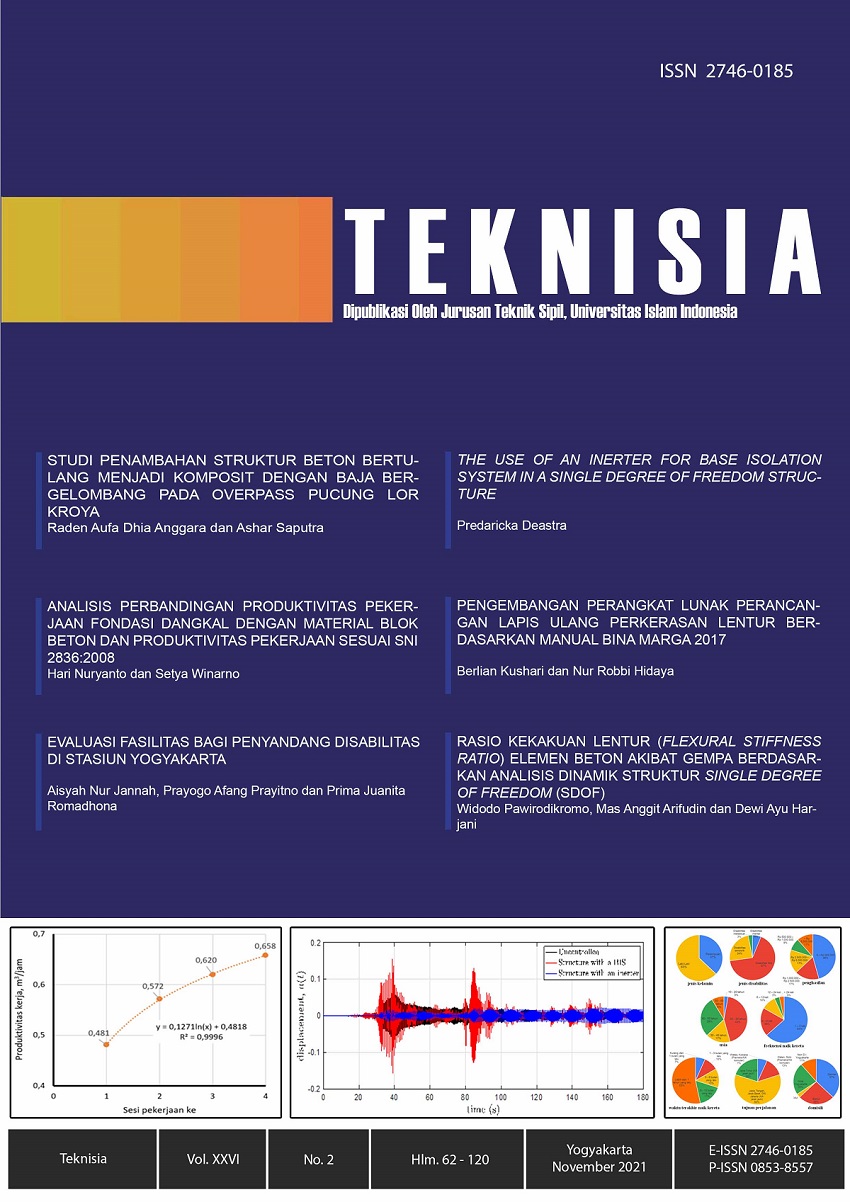Main Article Content
Abstract
The use of concrete block material instead of rubble stone on shallow foundation work has many advantages. One aspect that needs to be studied is its workforce productivity. This paper aims to elaborate workforce productivity on shallow foundation work with concrete block material and compare its result to Standard of SNI 2836:2008. Data are collected from construction project which has site-wide construction in Krandon and site-narrow construction in Keringan. The method of data collection has been done by direct investigation from the beginning to the end of the foundation project and complemented by photo and video. These findings have shown that workforce productivity on shallow foundation work with concrete block material both in wide-site and narrow site construction is higher than that of SNI Standards, i.e. 48,87% and 7,14% higher, respectively. Moreover, the productivity rate tends to increase due to the learning effect and adaptation on this foundation work done repetitively. There is a learning curve: y=0,1271.ln(x)+0,4818, in which y=productivity rate and x=work session.
Keywords
Article Details
Under the following term:
-
Attribution — You must give appropriate credit, provide a link to the license, and indicate if changes were made. You may do so in any reasonable manner, but not in any way that suggests the licensor endorses you or your use.
-
ShareAlike — If you remix, transform, or build upon the material, you must distribute your contributions under the same license as the original.
- No additional restrictions — You may not apply legal terms or technological measures that legally restrict others from doing anything the license permits.
References
- Badan Standarisasi Nasional. (2008). "SNI 2836-2008 tentang Tata Cara Perhitungan Harga Satuan Pekerjaan Fondasi untuk Konstruksi Bangunan Gedung dan Perumahan". Jakarta.
- Bao, Y., dan Li, V.C. (2020). "Feasibility Study of Lego-inspired Construction with Bendable Concrete". Automation in Construction, 113. 103161.
- Dahlia. (2019). "Produktivitas Tenaga Kerja Pada Pekerjaan Pondasi Pasangan Batu Belah Di Beberapa Proyek Di Kota Balikpapan". Tugas Akhir (tidak dipublikasikan). Politeknik Negeri Balikpapan.
- Hinze, J. W. (2008). "Construction Planning and Scheduling", 3rd Edition. Pearson.
- Husen, A. (2009). "Manajemen Proyek: Perencanaan, penjadwalan dan pengendalian proyek". Andi.
- Kedir, F., and Hall, D.M. (2021). "Resource Efficiency in Industrialized housing construction - A Systematic Review of Current Performance and Future Opportunities". Journal of Cleaner.
- Nuryanto, H., & Winarno, S. (2021). "Kurva Belajar pada Pekerjaan Pondasi Dangkal yang Menggunakan Material Blok Beton". Simposium Nasional Teknologi Infrastruktur (SNTI) Abad 21, 231–236.
- Olomalaiye, P. O., Jayawardane, A. K., & Harris, F. C. (1998). "Contruction Productivity Management ", 1st edition. Prentice Hall.
- Pramono, W. A., Winarno, S., & Teguh, M. (2020). "Pengaruh Penambahan Sekam Padi sebagai Agregat Halus terhadap Karakteristik Batako". Civil Engineering Environmental and Disaster Risk Management Symposium, 360–366.
- Ravianto, J. (1986). "Penelitian Kerja dan Produktivitas". Lembaga Pembinaan Manajemen.
- Ryu, J., McFarland, T., Banting, B., Hass, C.T., Abdel-Rahman, E. (2020). "Health and Productivity Impact of Semi-automated Work Systems in Construction". Automation in Construction, 120, 103396.
- Soekiman, A., Pribadi, K., Soemardi, B., Wirahadikusumah, & R.D. (2011). "Study on Factors Affecting Project Level Productivity in Indonesia". Annals of Faculty Engineering Hunedoara- International Journal of Engineering 9 3, pp 35-40.
- Wong, P., Cheung, S., & Cliff Hartcastle. (2007). "Embodying Learning Effect in Performance Prediction". Journal of Construction Engineering and Management - ASCE, 474–482.
References
Badan Standarisasi Nasional. (2008). "SNI 2836-2008 tentang Tata Cara Perhitungan Harga Satuan Pekerjaan Fondasi untuk Konstruksi Bangunan Gedung dan Perumahan". Jakarta.
Bao, Y., dan Li, V.C. (2020). "Feasibility Study of Lego-inspired Construction with Bendable Concrete". Automation in Construction, 113. 103161.
Dahlia. (2019). "Produktivitas Tenaga Kerja Pada Pekerjaan Pondasi Pasangan Batu Belah Di Beberapa Proyek Di Kota Balikpapan". Tugas Akhir (tidak dipublikasikan). Politeknik Negeri Balikpapan.
Hinze, J. W. (2008). "Construction Planning and Scheduling", 3rd Edition. Pearson.
Husen, A. (2009). "Manajemen Proyek: Perencanaan, penjadwalan dan pengendalian proyek". Andi.
Kedir, F., and Hall, D.M. (2021). "Resource Efficiency in Industrialized housing construction - A Systematic Review of Current Performance and Future Opportunities". Journal of Cleaner.
Nuryanto, H., & Winarno, S. (2021). "Kurva Belajar pada Pekerjaan Pondasi Dangkal yang Menggunakan Material Blok Beton". Simposium Nasional Teknologi Infrastruktur (SNTI) Abad 21, 231–236.
Olomalaiye, P. O., Jayawardane, A. K., & Harris, F. C. (1998). "Contruction Productivity Management ", 1st edition. Prentice Hall.
Pramono, W. A., Winarno, S., & Teguh, M. (2020). "Pengaruh Penambahan Sekam Padi sebagai Agregat Halus terhadap Karakteristik Batako". Civil Engineering Environmental and Disaster Risk Management Symposium, 360–366.
Ravianto, J. (1986). "Penelitian Kerja dan Produktivitas". Lembaga Pembinaan Manajemen.
Ryu, J., McFarland, T., Banting, B., Hass, C.T., Abdel-Rahman, E. (2020). "Health and Productivity Impact of Semi-automated Work Systems in Construction". Automation in Construction, 120, 103396.
Soekiman, A., Pribadi, K., Soemardi, B., Wirahadikusumah, & R.D. (2011). "Study on Factors Affecting Project Level Productivity in Indonesia". Annals of Faculty Engineering Hunedoara- International Journal of Engineering 9 3, pp 35-40.
Wong, P., Cheung, S., & Cliff Hartcastle. (2007). "Embodying Learning Effect in Performance Prediction". Journal of Construction Engineering and Management - ASCE, 474–482.
